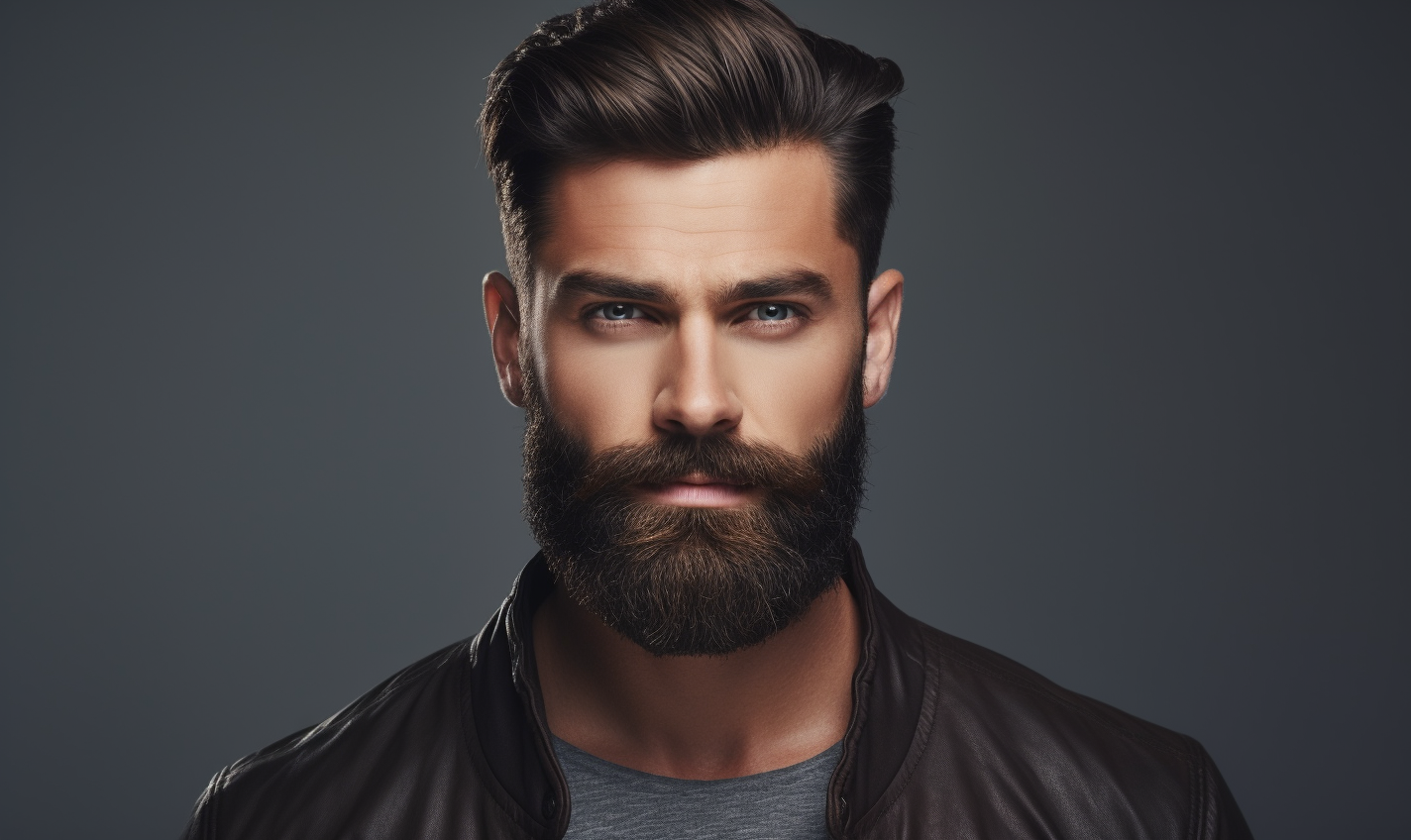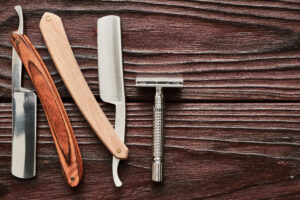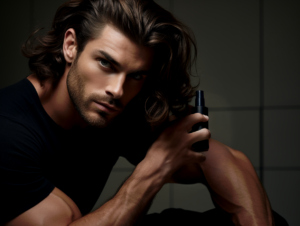Mastering the art of a perfect beard trim is no small feat.
The right approach can be the distinction between a disheveled scruff and an expertly groomed masterpiece.
A comprehensive beard trimming guide, however, can help you navigate this often overlooked aspect of men’s grooming.
No more guesswork or frustrating trial-and-error; just precise cuts and flawless styling every time you pick up your trimmer.
Table of Contents:
- The Art of Beard Trimming: A Comprehensive Guide
- Understanding Your Face Shape for the Perfect Beard Style
- Essential Tools for Proper Beard Trimming
- Step-by-Step Guide to Achieving Your Desired Beard Length
- Mastering the Art of Shaping Sideburns & Neckline
- Mastering Mustache Maintenance
- The Role of Aftercare in Maintaining a Healthy Beard
- The Right Way to Beard Trimming
- FAQs in Relation to Beard Trimming Guide
- Conclusion
The Art of Beard Trimming: A Comprehensive Guide
Finding the equilibrium between sustaining your desired length and forming a silhouette that matches your facial features is no simple task.
A well-groomed beard is a demonstration of self-control, care for the details, and one’s own fashion sense. But achieving this requires more than just chopping off excess hair; it involves precision shaping for optimal results.
Select Your Tools Wisely
Your arsenal plays a significant role in effective grooming. If you’re rocking a short stubble or light whiskers, guide combs might suffice as they ensure uniformity while minimizing risks of accidental cuts.
On the other hand, if you prefer sporting longer strands on your chinny-chin-chin, specialized tools like electric trimmers are indispensable assets due to their adjustable settings which allow millimeter-precise control over how much hair gets cut.
Hair Scissors – The Unsung Heroes
In addition to electronic devices designed specifically for cutting facial hairs such as clippers, another important tool often overlooked by many men during the process itself would undoubtedly have been a pair of high-quality scissors. These come especially handy when dealing with areas around the lips and nostrils where one needs extra caution to avoid any unwanted injuries caused unintentionally through careless handling of the equipment used. They are purposefully meant to provide ultimate comfort and ease of use whilst performing the task at hand effectively and efficiently without causing unnecessary discomfort along the way, thereby ensuring a smooth sailing journey towards achieving the perfect look every single time regardless of the circumstances involved whatsoever thus far.
Finding Your Ideal Length And Style
Determining what works best for you in terms of both preferred lengths/styles related directly back onto oneself specifically is a crucial part of the overall grooming routine practiced regularly amongst males worldwide today. Hence, why we’ve included this section here within this comprehensive guide aimed primarily towards providing insightful information based upon years worth of accumulated knowledge gained through extensive research conducted throughout the industry in the past few decades alone. So remember: practice makes perfect; so don’t get discouraged if the first few attempts seem less stellar compared to the expectations set forth initially
Key Takeaway:
Beard trimming is an art, balancing desired length and flattering shape. Selecting the right tools, like guide combs for short stubble or electric trimmers for longer beards, is crucial. Don’t overlook hair scissors for precision work around lips and nostrils. Discover your ideal beard length and style through practice – remember, it’s all part of mastering this important grooming skill.
Understanding Your Face Shape for the Perfect Beard Style
The perfect beard style is not a one-size-fits-all solution. It’s all about enhancing your unique facial features and understanding how different face shapes require various approaches.
Determining Ideal Beard Styles Based on Facial Structure
Your face shape plays an integral role in determining which beard styles will complement you best. For instance, rounder faces benefit from fuller beards that add definition, while slim or narrow faces look more appealing with streamlined looks to balance out their natural bone structure.
Oval-faced men are blessed as most beard styles tend to flatter this versatile shape. From short boxy beards to full stubble, these options can highlight balanced features perfectly without overwhelming them.
On the other hand, diamond-shaped faced men have strong cheekbones and should aim at softening their angular jaws by keeping hair longer around the chin area than the sides.
With a clear comprehension of the importance of understanding your own individual face shape when choosing the ideal beard style, we now move onto the next critical aspect: having the right tools ready before starting the process.
Unlock your best look. Your face shape dictates the perfect beard style. Round faces? Go full for definition. Slim or narrow? Streamline it. Oval-faced gents, rejoice – most styles suit you. #BeardGuideClick to Tweet
Essential Tools for Proper Beard Trimming
Achieving a well-groomed beard starts with the right tools. An electric razor is your go-to tool, offering precision and control that’s ideal whether you’re new to grooming or an experienced hand.
The second must-have in your arsenal? A good quality pair of facial hair scissors. They give you the power to make precise cuts when shaping your beard or trimming stray hairs – something regular scissors just can’t handle due to their design limitations.
Why High-Quality Tools Matter in Beard Trimming
If there’s one thing we know about men’s grooming, it’s this: high-quality tools matter significantly in achieving the perfect trim style. For instance, a sharp electric razor not only glides smoothly over skin without causing irritation but also provides an extremely close-cutting experience.
Your stubble game will be strong too if you invest in a dedicated stubble trimmer; its ability to provide even trims at various lengths makes maintaining shorter beards easier than ever before.
Bear this in mind though: low-grade tools may lead to uneven trims and potential damage on your facial hair follicles leading to patchy growth patterns over time. So investing more upfront ensures superior performance as well as longevity compared to cheaper alternatives out there today.
Selecting The Right Tool For Your Beard Type
Different types of beards require different kinds of attention, which means using appropriate tools accordingly. For example, a full-bearded man might find a sturdy electric razor more useful whereas someone who prefers light stubble would benefit from owning a dedicated stubble trimmer instead.
Moreover, the texture and thickness of whiskers play a crucial role too. Thicker, denser ones often need sharper, stronger blades (like those found in higher-end razors) while finer, sparser ones do fine with standard blades available in most common models out there today.
Caring For Your Grooming Equipment
- Maintaining cleanliness and functionality within each piece used during routine matters greatly towards the overall health status regarding the user’s face and surrounding areas. Simply put, clean tools equate to a clean grooming experience. Regular upkeep, like wiping down surfaces and sanitizing blades, ensures not only effective performance but also a hygienic grooming process that contributes to healthy skin and a polished appearance.
- Proper storage plays a pivotal role in extending the lifespan of your grooming tools. Keep them in a dry, cool place, away from moisture and direct sunlight. This prevents rust, deterioration, and the growth of mold or bacteria that can compromise the tools’ effectiveness and hygiene.
- Regular maintenance, such as oiling movable parts, tightening screws, and sharpening blades, is key to preserving the precision and efficiency of your grooming equipment. Dull or improperly functioning tools not only hinder your grooming routine but can also cause irritation or accidental nicks.
- For electric grooming tools, adhere to the manufacturer’s instructions regarding charging and usage. Overcharging or using the wrong voltage can lead to reduced battery life and potentially damage the equipment. Following these guidelines ensures optimal performance and longevity.
Key Takeaway:
For a polished beard, invest in high-quality grooming tools like an electric razor and facial hair scissors. The right tool depends on your beard type and texture. Remember, clean equipment is key to maintaining healthy skin and facial hair.
Step-by-Step Guide to Achieving Your Desired Beard Length
Achieving your desired beard length is a journey that requires understanding the growth cycle of hair. Setting realistic expectations based on your individual growth rate is essential for achieving the perfect beard.
This practice not only helps manage constant hair growth but also promotes healthier strands by eliminating split ends and damaged hairs.
Determining Your Ideal Beard Length
Your personal style plays a significant role before you start trimming. Are you aiming for short stubble or do longer hairs better suit your lifestyle? Remember: maintaining an impressive mane requires commitment.
Tackling Knots Before Trimming
Knots can be tricky. To detangle knots effectively without causing unnecessary damage or pain, use a wide-toothed comb designed specifically for beards.
The Process Explained: Start Trimming
- You’ve determined how long (or short) you want your whiskers; now let’s get down to business – time to start trimming.
- To ensure even cuts due to poor visibility, set up in front of a well-lit mirror where all angles are clearly visible.
- Frequent trims promote healthy growth by removing dead ends and encouraging new cell generation.
Now that we’ve covered achieving and maintaining preferred lengths, let’s shift focus towards shaping other vital elements contributing towards the overall appearance – sideburns and neckline.
Embark on the journey to your perfect beard length with our step-by-step guide. Learn how to manage growth, determine ideal length, tackle knots and master trimming for a refined look. #BeardGrooming #MensStyleClick to Tweet
Mastering the Art of Shaping Sideburns & Neckline
The way you shape your sideburns and neckline can drastically alter your overall look. It’s not just about how long or thick your facial hair is, it’s also about precision in trimming these areas.
Your sideburns serve as a transition between your hairstyle and beard; hence, they should be well-groomed. Using clippers set at an appropriate length for sideburns, start from the top moving downwards while maintaining steady hand movement to ensure evenness throughout.
Finding Your Perfect Beard Neckline
A poorly defined beard neckline can disrupt the aesthetics of meticulously maintained facial hair. The secret lies in knowing where exactly to draw that line – too high might make you appear neckless, whereas too low could give off an unkempt vibe.
Imagine two lines meeting directly above Adam’s apple. One starts behind the earlobe following the jawline down towards the neck, the other begins at the opposite end doing the same thing on the other side till both meet, forming a V-shape over the Adam’s apple.
This technique helps create a natural-looking boundary for beard growth below the chin area, keeping the rest clean-shaven and creating a sharp contrast, enhancing overall appeal.
Tapering: A Key Step Towards Perfection
Tapering involves gradually reducing the length of hairs around the edges, giving a smoother transition from the thick, dense part of the beard to the bare skin on the neck region, thus avoiding abrupt stoppage which often looks unnatural, especially with longer beards.
In essence, mastering artful shaping techniques for both sideburns and neckline contributes significantly towards achieving a polished, refined look, setting apart casual growers from serious groomers who understand the importance each detail plays in crafting a masterpiece out of their own unique facial features.
As we continue our comprehensive guide into superior grooming practices, remember no aspect should ever be overlooked. Next up, let’s dive deeper into another crucial component – caring for the mustache.
Key Takeaway:
Perfecting your beard’s look is about more than just length and thickness. It involves mastering the art of shaping sideburns, defining a flattering neckline, and skillfully tapering edges for smooth transitions. Attention to these details can elevate your grooming game from casual grower to serious groomer.
Mastering Mustache Maintenance
Tending a mustache isn’t as intricate as it may appear. With regular care and the right tools, such as rounded scissors designed for facial hair, you can easily keep your stache in top form.
Your mustache contributes significantly to your overall facial appeal. Hence, ensuring its neatness should be an integral part of your grooming routine.
Caring For The Upper Lip Area
The area above the upper lip serves as the home base for your moustach glory. Keeping this region clean will enhance even the most formidable of mustaches.
A good practice involves combing through regularly to prevent food particles or other debris from getting trapped within its bristles. This also helps identify uneven growth patterns or stray hairs that need trimming away.
The Role Of Rounded Scissors In Trimming
Rounded scissors are indispensable when maintaining a well-groomed mustache. Their curved tips allow precise cuts without risking nicks on sensitive skin around the nose and mouth regions. Start by combing down so all hairs lay flat against the upper lip line. Then carefully trim along the natural curvature, ensuring equal length across the width. Remember, it’s always better to err on the side of caution when removing length; you can always cut more off if needed, but growing it back takes time.
Tips To Achieve A Well-Groomed Look
- Beyond just cutting, you might consider applying a small amount of wax to style and shape. It provides control for unruly strands while providing a polished finish.
- Furthermore, don’t forget to pay attention to the corners where the mustache meets the beard. This transition point is often overlooked yet crucial for achieving a cohesive look between the two elements of your facial hair ensemble.
As we move forward, maintenance doesn’t stop at mere cutting and shaping. Another vital step many men overlook is aftercare. In the next section, we will delve into the role aftercare plays in maintaining a healthy and luxurious beard, including how to incorporate products like oil and balm into your daily routine.
Key Takeaway:
Perfect mustache maintenance is a cinch with regular care, the right tools like rounded scissors, and attention to detail. Keep your upper lip area clean, comb regularly to avoid debris trap and spot uneven growths. Don’t forget aftercare for a healthy, luxurious beard.
The Role of Aftercare in Maintaining a Healthy Beard
Once you have achieved mastery of the art of beard trimming, aftercare is an essential part to maintain a healthy and well-groomed facial hair. This is a critical part of maintaining a healthy and well-groomed beard that goes beyond simply wielding scissors or trimmers.
Once you’ve achieved the art of beard trimming, it is essential to focus on aftercare; this includes utilizing products such as aftershave balm and beard oil for a healthy and well-groomed facial hair.
1. Regularly Use Quality Face Wash and Softener
Caring for the skin under your facial hair is just as important as caring for the hairs themselves. Using quality face wash not only removes dirt but also helps prevent irritation from coarse hairs rubbing against sensitive skin.
A softener plays an equally crucial role by ensuring both skin and beards remain smooth while keeping bushier ones manageable. Make these two steps regular fixtures in grooming routines if you want healthier-looking longer beards.
2. Apply Soothing Aftershave Balm Post-Trimming
An aftershave balm applied post-trim soothes potential razor burn or redness caused by trimming tools while providing antibacterial protection – preventing ingrown hairs or infections down the line. It moisturizes too, so say goodbye to dry flaky patches underneath those lush locks on the chin…
3. Conditioner Treatments: Applying Beard Oil
- Maintain moisture within each individual strand with regular applications – giving them shine without appearing greasy. Plus, they often come scented, adding a masculine fragrance touch which doubles up the cologne effect.
4. Dealing With Split Ends
If split ends are a concern (which they should be), don’t worry, there’s a solution at hand: Regular trims coupled with nourishing balms keep pesky splits at bay, promoting overall healthy texture and appearance over time.
Now let’s talk about the application order:
- Start off by washing your face thoroughly.
- Apply the softener evenly across the entire area
Key Takeaway:
Beard aftercare is a game-changer for maintaining an impressive mane. It’s not just about trimming; quality face wash, softener, aftershave balm and beard oil are your new best friends. Regularly tackle those split ends too. Remember: great grooming routines lead to healthier-looking beards.
The Right Way to Beard Trimming
Accurately trimming your facial hair requires skill, patience and the correct approach. Having the correct approach to trimming your facial hair can significantly upgrade your appearance, no matter if you prefer a light stubble or an extensive beard.
Before embarking on this journey towards mastering the craft of beard trimming, preparation comes first. This includes ensuring your facial mane is clean and dry prior to starting as wet hairs may give off deceptive length leading to over-trimming mishaps.
Paving Your Path: Preparation Matters
Investing in quality combs goes beyond aesthetic appeal – these tools are instrumental in detangling knots while also guiding scissors or trimmers for precise cuts during grooming sessions. Remember gents – good grooming starts long before those clippers come into play.
Cutting with Precision: The Art Of Trimming
When we talk about cutting, what really matters isn’t merely removing excess hair but crafting a style that suits your personality and enhances your features, setting you apart from the crowd.
In terms of deciding the desired length, personal preference, and face shape considerations discussed earlier, a guide would prove helpful.
Using an electric razor with adjustable settings gives you control over how much gets removed with each pass, allowing you to achieve the perfect balance between too little and too much.
Defining Sideburns and Neckline: Moving beyond general trims, delve into shaping sideburns and defining necklines. These two areas are often overlooked yet vital in achieving a polished look. Tapering the neckline creates a smooth transition between head hair and facial mane, giving a refined appearance.
Mustache Care:
A well-groomed mustache adds charm to any man’s persona, hence taking care of it becomes an essential part. Rounded scissors keep the upper lip area neat without making drastic changes to the overall look.
Aftercare Maintenance:
Once you’ve had a successful trimming session, aftercare plays a crucial role in maintaining healthy, lustrous beards. Products like aftershave balm prevent flyaways , moisturize the skin underneath, and promote a well-groomed appearance. Aftershave balms, enriched with soothing ingredients like aloe vera and chamomile, offer a refreshing and nourishing touch. Gently massaging the balm into your beard and skin helps seal in moisture, reduce irritation, and keep your facial hair looking and feeling its best throughout the day.
Key Takeaway:
Beard trimming isn’t just a grooming routine; it’s an art that requires precision, patience, and the right tools. From preparing your beard to cutting with accuracy, shaping sideburns and neckline to mustache care and aftercare maintenance – each step is vital in achieving a polished look. Remember fellas, good grooming starts long before those clippers come into play.
FAQs in Relation to Beard Trimming Guide
How do you properly trim a beard?
To properly trim a beard, start by combing it out to detangle knots. Then use high-quality tools like an electric razor or facial hair scissors to achieve your desired length and shape.
How long should a beard be for a beard trim?
The ideal time to trim your beard is when it reaches about 1-2 inches in length. This allows enough growth for proper shaping while maintaining neatness.
Where should your beard neckline be?
Your beard neckline should follow the curve of your jawline, ending at the top index finger above Adam’s apple. It’s crucial not to cut too high, as this can distort face proportions.
What number should you trim your beard?
The guard number on a clipper correlates with the length of the cut. For example, a #4 guard leaves half an inch of hair, but always start higher and work down until you find your preferred length.
Conclusion
Gaining proficiency in beard-trimming is a must for any man.
This comprehensive guide has given you a deep dive into all things related to maintaining and styling your facial hair.
You’ve learned about understanding your face shape, using high-quality tools, achieving the desired length, shaping sideburns and neckline, mustache care, and aftercare practices.
Each tip in this beard trimming guide plays a crucial role in enhancing your overall look.
The journey doesn’t end here though! There’s always more to learn when it comes to grooming and lifestyle enhancements.




